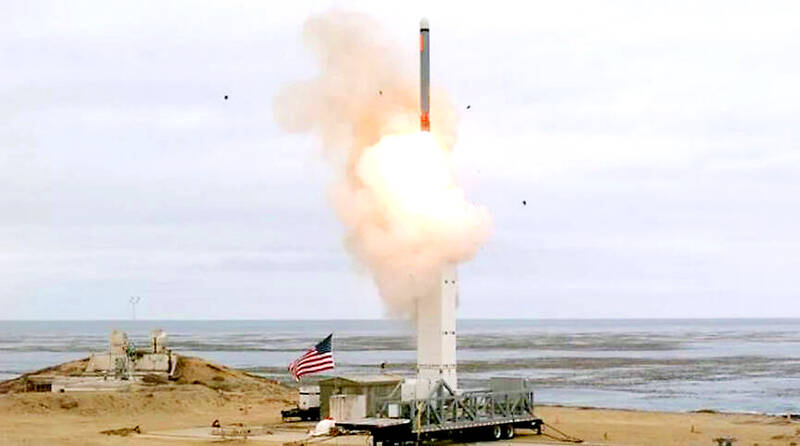The US Navy would start fielding an anti-ship version of its Tomahawk cruise missile on destroyers by late September in what US Fleet Forces Command Admiral Daryl Caudle sees as a “game-changer” against a numerically superior Chinese fleet.
An anti-ship version of the US’ best-known non-nuclear missile, which is currently used for land attack, would greatly increase the service’s lethality, Caudle said.
“The more fungible you make a weapon, the more utility it has for different circumstances,” he said.

Photo: Screengrab from Defense Visual Information Distribution Service’s Web site
Fielding a new seaborne version of the Tomahawk would add to a growing US arsenal of ship-attack weapons, such as the new Long-Range Anti-Ship Missile, complementing submarine-launched torpedoes in the event of conflict in Asia.
Building it for submarine and destroyer launch would “make it a very high-utility weapon,” he said.
The navy plans to start fielding the new missiles on destroyers by Sept. 30 and make them available for submarine deployments between April and June next year once they complete testing, Tomahawk deputy program manager Chip Whipkey said.
The service is looking to purchase as many as 1,302 Maritime Strike Tomahawks from RTX Corp.
The schedule for outfitting the new maritime strike missile on destroyers fits roughly within the Pentagon’s plan to field thousands of drones in the Indo-Pacific region to counter China. That is known as the Replicator program, which the military aims to deploy on a large scale in August.
The navy’s growing arsenal also uses artificial intelligence algorithms on its submarine sonar systems “to help distinguish man-made noise sources from biological sources” such as fish, Caudle said.
China’s projected massive naval increase has fixated lawmakers intent on pouring billions into US warship construction to boost the navy’s roughly 300 inventory.
The US estimates that China’s fleet of more than 370 ships, including submarines and aircraft carriers, would grow to 435 by 2030.
Still, Caudle urged caution in launching into a “shipbuilding arms race,” saying the focus should be on US capabilities per vessel.
“It’s tempting to get in a shipbuilding arms race where we really are trying to go tit-for-tat, where we’re judging the value of combat power of a naval force by the numbers,” he said. “I don’t think that’s a good strategy.”
“A better strategy is to build high-end, highly capable, large payload volume ships like we have,” Caudle said, citing Arleigh Burke-class guided-missile destroyers and the US fleet submarines aircraft carriers.
A projected increase in China’s fleet comes with challenges, including more munitions purchases and crew, he said.
“You have to crew all those ships. You have to sustain all those ships. You’ve got to have a place for them to moor” and have housing for the crew, he said. “So it’s not just buying ships.”

TRAGEDY STRIKES TAIPEI: The suspect died after falling off a building after he threw smoke grenades into Taipei Main Station and went on a killing spree in Zhongshan A 27-year-old suspect allegedly threw smoke grenades in Taipei Main Station and then proceeded to Zhongshan MRT Station in a random killing spree that resulted in the death of the suspect and two other civilians, and seven injured, including one in critical condition, as of press time last night. The suspect, identified as a man surnamed Chang Wen (張文), allegedly began the attack at Taipei Main Station, the Taipei Fire Department said, adding that it received a report at 5:24pm that smoke grenades had been thrown in the station. One man in his 50s was rushed to hospital after a cardiac arrest

SAFETY FIRST: Double the number of police were deployed at the Taipei Marathon, while other cities released plans to bolster public event safety Authorities across Taiwan have stepped up security measures ahead of Christmas and New Year events, following a knife and smoke bomb attack in Taipei on Friday that left four people dead and 11 injured. In a bid to prevent potential copycat incidents, police deployments have been expanded for large gatherings, transport hubs, and other crowded public spaces, according to official statements from police and city authorities. Taipei Mayor Chiang Wan-an (蔣萬安) said the city has “comprehensively raised security readiness” in crowded areas, increased police deployments with armed officers, and intensified patrols during weekends and nighttime hours. For large-scale events, security checkpoints and explosives

A car bomb killed a senior Russian general in southern Moscow yesterday morning, the latest high-profile army figure to be blown up in a blast that came just hours after Russian and Ukrainian delegates held separate talks in Miami on a plan to end the war. Kyiv has not commented on the incident, but Russian investigators said they were probing whether the blast was “linked” to “Ukrainian special forces.” The attack was similar to other assassinations of generals and pro-war figures that have either been claimed, or are widely believed to have been orchestrated, by Ukraine. Russian Lieutenant General Fanil Sarvarov, 56, head

PUBLIC SAFETY: The premier said that security would be tightened in transport hubs, while President Lai commended the public for their bravery The government is to deploy more police, including rapid response units, in crowded public areas to ensure a swift response to any threats, President William Lai (賴清德) said yesterday after a knife attack killed three people and injured 11 in Taipei the previous day. Lai made the remarks following a briefing by the National Police Agency on the progress of the investigation, saying that the attack underscored the importance of cooperation in public security between the central and local governments. The attack unfolded in the early evening on Friday around Taipei Main Station’s M7 exit and later near the Taipei MRT’s Zhongshan